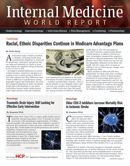Publication
Article
Internal Medicine World Report
Mu Opioid Receptor Binding and Smoking Pleasure
Author(s):
For smokers and other users of nicotine, the rewarding effects of the substance had been associated with activation of nicotine receptors. But studies have found evidence that the endogenous opioid system is also involved in creating this sense of pleasure.

For smokers and other users of nicotine, the rewarding effects of the substance had been associated with activation of nicotine receptors. But studies have found evidence that the endogenous opioid system is also involved in creating this sense of pleasure.
In an article published online Dec. 10, 2014 in PLOSone, researchers reported on their efforts to test the hypothesis that acute cigarette smoking increases release of endogenous opioids in the brain and that smokers have an up-regulation of mu opioid receptors (MORs) when compared to nonsmokers.
The team reasoned that understanding the acute and long-term effects of nicotine on the opioid system” might provide better strategies for the development of treatment medications for nicotine dependence.”
They recruited 10 smokers and 10 age-matched non-smokers, both men and women all aged from 21 to 50 and with an IQ of at least 85.
Each participant received 2 PET scans on 2 separate days. The researchers wanted to see the effects of smoking a cigarette on the binding of the mu-opioid agonist radioligand [11C] carfentanil in non-smokers compared to smokers.
Prior to each scan, subjects smoked either a cigarette with .6 mg of nicotine or one containing just .05mg of nicotine. The researchers collected blood during the scans.
Since [11C] carfentanil binding in the brain was sensitive to competition with endogenous opioids, the team hypothesized that its binding would be decreased after smoking cigarettes. They also expected that chronic smokers would show decreased endogenous opioid release when not under the effects of nicotine and thus would have increases in MOR when tested at baseline.
Their findings indicated that “the behaviors, the paraphernalia, and the environment associated with cigarette smoking, even in the absence of nicotine likely contribute to the craving and reward of cigarette smoking in some smokers.
“In summary, smokers demonstrated correlations in [11C] carfentanil BP/ND with nicotine dependence and smoking status,” suggesting the need for further investigation of the role of MOR in nicotine dependence.






